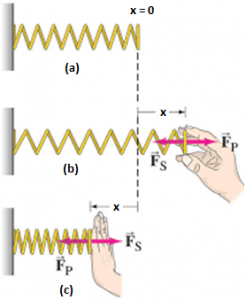When we compress or extend a stretched spring, we experience a force equal to that applied by us in the opposite direction. Have you wondered why this happens? When a spring deviates from its mean position, it tends to restore its equilibrium by exerting a force equal and opposite to the external force. But in which way can this force be helpful to us? Can we harness it in any form? We have seen the application of spring force in bicycle carriers and launching devices where the energy gained by disturbing the equilibrium of the spring is utilized as its potential energy and converted to other forms. In this section, we will learn more about this stored energy.
What is Potential of the spring?
If the usual position (i.e. When not stretched), there is no energy in the spring. But, when the position is altered from its usual position, the spring is able to store energy by virtue of its position. This stored energy is known as Potential Energy. Potential Energy of the spring is the potential energy stored as a result of deformation of a particular elastic object, or a spring. It described the work done to stretch the spring and depends on the spring constant K and the distance stretched.
Formula to find the Potential Energy of the spring?
Let us consider a spring fixed to a rigid wall, as shown in the figure below. The spring is assumed to be ideal and considered as massless. In figure (a), the spring is at the equilibrium position, in figure (b) the spring is stretched such that it gets displaced by a value x from its equilibrium position and in figure (c) it is compressed such that it gets displaced by a value – x, from its equilibrium position.
The spring is assumed to be ideal and considered as massless. In figure (a), the spring is at the equilibrium position, in figure (b) the spring is stretched such that it gets displaced by a value x from its equilibrium position and in figure (c) it is compressed such that it gets displaced by a value – x, from its equilibrium position.
As we know, in an ideal spring, the spring force is proportional to the displacement (x) of its ends from the equilibrium position. So, according to Hooke’s Law,
Fs = -Kx
Where,
Fs = spring force,
x = the displacement from the equilibrium position,
K = spring constant.
The spring constant is the characteristic property of the spring. It depends upon the material of construction and is measured in the units of N/m.
As shown in fig (b) above, we have pulled the spring such that resultant displacement equal to Xm is measured. The work done by the spring is given by,
\({{W}_{s}}\,=\,\int\limits_{0}^{{{X}_{m}}}{{{F}_{s}}\,dx}\,=\,-\,\int\limits_{0}^{{{X}_{m}}}{K\,dx}\,=\,-\,\frac{K{{({{X}_{m}})}^{2}}}{2}\)
Here the work done by the external pulling force Fp is given by
\({{F}_{p}}\,=\,\frac{K{{({{X}_{m}})}^{2}}}{2}\)
Which is positive since it overcomes the spring force.
Same is observed for a spring being compressed by a distance x.
If we move the spring from an initial displacement Xi to a final displacement Xf, the work done by the spring force is given as,
\({{W}_{s}}\,=\,-\int\limits_{{{X}_{i}}}^{{{X}_{f}}}{dx}\,=\,\frac{K\,\,{{({{X}_{i}})}^{2}}}{2}\,-\,\frac{K\,\,{{({{X}_{f}})}^{2}}}{2}\)
The potential energy V(x) of a spring is considered to be zero when the spring is at the equilibrium position. When it is extended to a displacement X, the ends are stationary, hence the kinetic energy is zero. Thus, the potential energy is equal to the total external work done on the system.
Hence,
\({{W}_{ext}}\,=\,{{W}_{p}}\,=\,V(x)\,=\,\,\frac{K\,\,{{(x)}^{2}}}{2}\).
How to find the Potential Energy of the spring?
Problem: The spring constant and displacement of a stretched string is 1000 N/m and 0.5m respectively. Determine the Potential Energy stored in the stretched string.
Solution: Given,
K = Spring Constant = 1000 N/m,
x = Spring Displacement = 0.5m.
Now,
Potential Energy of a string = \(\frac{K\,{{(x)}^{2}}}{2}\)
= \(\frac{1000\,{{(0.5)}^{2}}}{2}\)
= 125 Joules.
Therefore,
Potential Energy of a string is 125 Joules.
